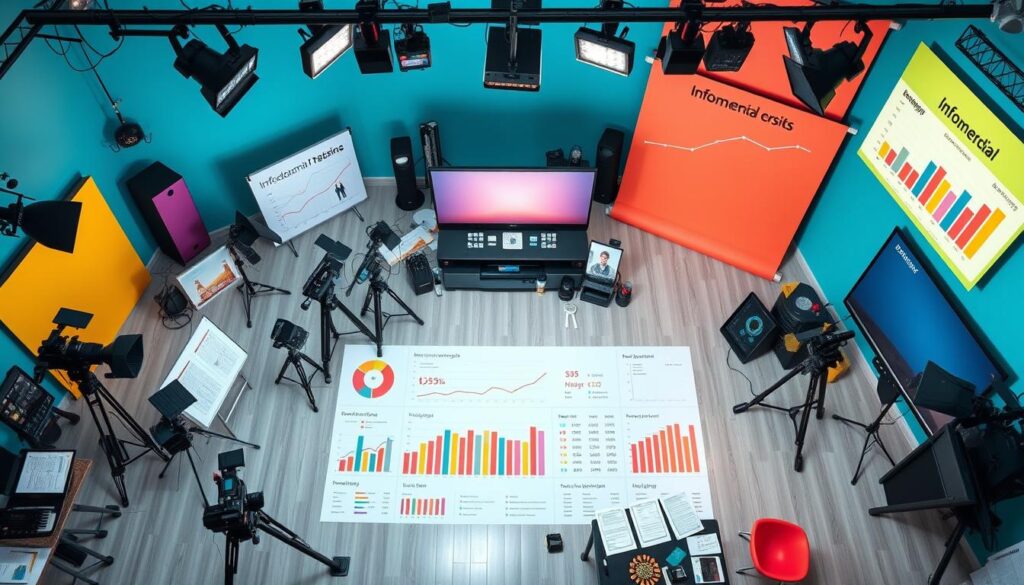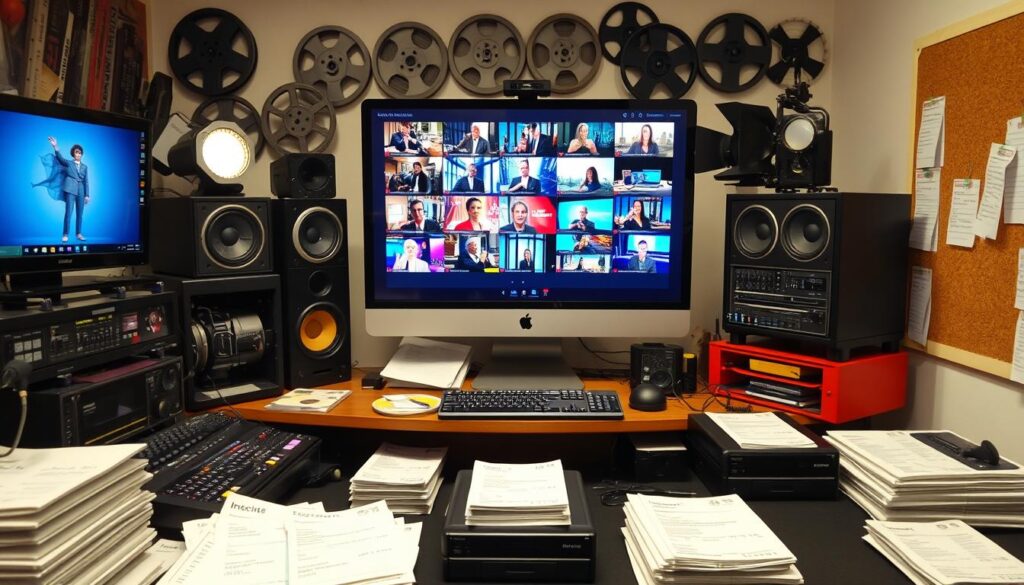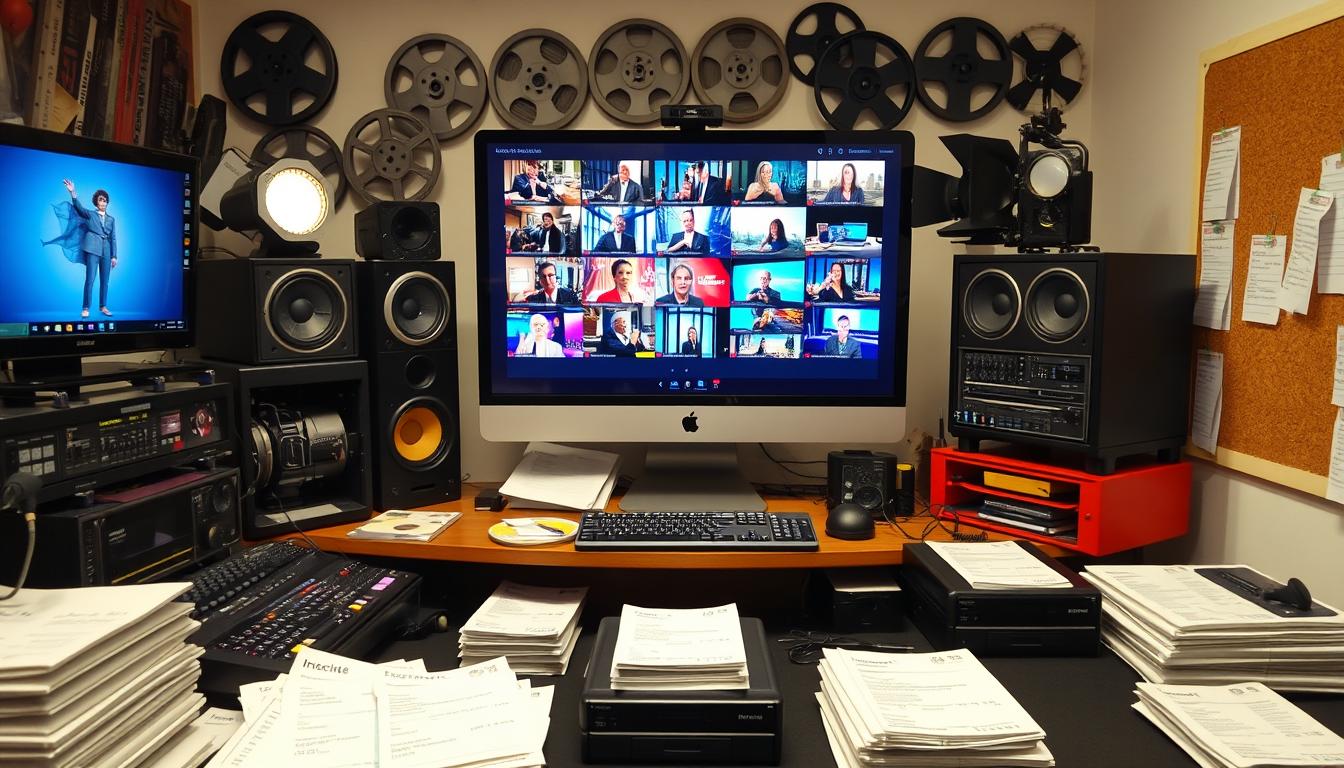Infomercials are a strong marketing tool for businesses to show off their products and boost sales. But, the cost of making and airing an infomercial can be a big deal for companies thinking about it. In this detailed guide, we’ll look at the different costs of making a successful infomercial campaign. This includes everything from the first steps to the final airtime fees.

Key Takeaways
- Infomercial production costs can vary widely, ranging from tens of thousands to millions of dollars, depending on the complexity and scale of the project.
- Factors that influence the overall cost include pre-production, filming, post-production, talent compensation, and media buying.
- Understanding the financial implications of an infomercial campaign is crucial for businesses to develop an effective and sustainable marketing strategy.
- Careful planning and budgeting are essential to ensure the infomercial production and airing costs align with the expected return on investment.
- Partnering with experienced infomercial production and media buying professionals can help businesses maximize the impact of their investment.
Understanding the World of Infomercial Production
Infomercials have changed a lot since they started. They used to be seen as a fun novelty. Now, they are a key way for companies to show off their products and reach more people.
The Evolution of Direct Response Television
DRTV began in the 1950s with the “long-form commercial.” Over time, it has improved a lot. Now, infomercials use stories, famous people, and smart placement to grab viewers and sell products.
Why Companies Choose Infomercials
- Increased product visibility and brand awareness
- Opportunity to showcase product features and benefits in detail
- Ability to build trust and establish a personal connection with the audience
- Potential for immediate sales and lead generation
Key Players in Infomercial Creation
Making a great infomercial needs a skilled team. This includes producers, directors, writers, and marketing experts. They work together to create a story, pick the right people to present it, and make sure it follows the rules and best practices.
| Role | Responsibilities |
|---|---|
| Producer | Oversees the entire production process, from conceptualization to final delivery |
| Director | Guides the creative vision and ensures the infomercial is visually engaging |
| Writer | Crafts the script and narrative, ensuring the messaging is persuasive and informative |
| Marketing Expert | Develops the marketing strategy, including media buying and audience targeting |
Working together, these key players make an infomercial that grabs the audience and helps the brand succeed.
How Much Does It Cost to Do an Infomercial: Base Production Expenses
Creating an infomercial requires a lot of money, from the start to the end. Let’s look at the basic costs for making an infomercial.
The base of any infomercial production budget starts with the script and storyboard. This is the first step, needing careful planning and smart choices. The cost for this can be $5,000 to $25,000, depending on the product or service.
After the script and storyboard are ready, it’s time to film. The cost for filming an infomercial can change a lot. It depends on how many days you film, where you film, and how fancy the production is. A simple infomercial might cost $10,000 to $50,000. A more detailed one could be $50,000 to $150,000. And a top-notch infomercial with fancy sets and effects could be over $150,000.
Remember, these numbers are just the beginning. The real infomercial production budget can change a lot. Good planning, talking prices down, and making smart choices can help keep costs low and make a great infomercial.
Production Time and Planning Requirements
Making a good infomercial needs careful planning and knowing the timeline. It starts with the idea and goes through the final touches. Each step is important and needs to be well-coordinated.
Pre-Production Timeline
The pre-production phase is key for a great infomercial. It includes writing the script, making storyboards, finding actors, and setting up locations. This part can take from a few weeks to months, making sure everything is perfect.
Shooting Schedule Considerations
The shooting schedule is crucial for an infomercial. It depends on the scenes, the actors’ schedules, and how many takes are needed. Good TV commercial planning helps keep the shooting on track and within the timeline.
Post-Production Duration
The post-production phase is just as important as the others. It includes editing, adding special effects, color correction, and mixing the audio. This can take weeks or even months, depending on the project’s complexity and the quality wanted.
Understanding the infomercial production timeline is essential. It involves knowing each stage and coordinating everything. With good planning, businesses can make sure their infomercial is made well and on time.
| Phase | Estimated Timeline |
|---|---|
| Pre-Production | 4-12 weeks |
| Shooting | 2-5 days |
| Post-Production | 4-12 weeks |
Studio and Location Rental Fees
Producing an infomercial comes with costs for filming locations. This includes renting TV studios and permits for on-location shoots.
TV studio rental fees vary a lot. They can be a few hundred dollars for a small studio or thousands for a big one. The price depends on the studio’s size, equipment, and reputation.
For filming on location, you’ll need permits, location fees, and to design the set. Permits can cost hundreds to thousands of dollars. Infomercial set design is also pricey, needing to look good and work well for the production.
| Cost Factor | Average Range |
|---|---|
| TV studio rental costs | $500 – $5,000 per day |
| On-location filming expenses | $500 – $10,000 per location |
| Infomercial set design | $1,000 – $50,000 |
Planning and budgeting are key for finding the right filming spots for infomercials. Knowing the costs helps companies plan better and use their money wisely.
Talent and Host Compensation
Creating a great infomercial depends a lot on the talent and personalities on screen. The cost to get the right host, celebrity endorsers, and actors varies a lot. This depends on their fame, experience, and what’s common in the industry.
Celebrity Host Costs
Getting a famous celebrity to host can cost a lot. Fees can go from $50,000 to $1 million or more for big names. The cost depends on the celebrity’s fame, how involved they are, and how long they’re on screen.
Supporting Talent Expenses
Infomercials also have a supporting cast. These actors and personalities can cost between $500 to $5,000 per day. The cost depends on their experience, if they’re in a union, and the size of their role.
Professional Testimonial Fees
Infomercials often use expert testimonials to build trust. These can cost from $500 to $10,000 or more. The cost depends on the expert’s knowledge, fame in their field, and how long they appear.
Managing talent and host costs is key for a successful infomercial. With careful planning and choosing the right talent, you can make a big impact. This all while keeping within your budget.
Equipment and Technical Requirements
Making a good infomercial needs a lot of quality video equipment and technical tools. This includes cameras, lights, sound systems, and special tools for showing products. The costs for these technical parts can quickly grow.
Choosing the right video production equipment is key. You can pick from DSLR or cinema cameras, which cost $2,000 to $20,000. Lighting, like LED panels and softboxes, adds $1,000 to $5,000 more.
Good sound is also vital for infomercials. High-quality microphones, both wireless and wired, cost $500 to $2,000. You might also need sound mixers, boom poles, and other gear, adding $500 to $2,000 more.
The needs for TV commercial technical costs and infomercial filming gear depend on the product. Special tools like green screens or motion control rigs can cost $500 to $5,000.
| Equipment Category | Estimated Rental Cost | Estimated Purchase Cost |
|---|---|---|
| Camera | $2,000 – $5,000 | $5,000 – $20,000 |
| Lighting | $1,000 – $3,000 | $2,000 – $5,000 |
| Audio | $500 – $1,500 | $1,000 – $2,500 |
| Specialized Equipment | $500 – $3,000 | $1,000 – $5,000 |
Planning and budgeting for the video production equipment, TV commercial technical costs, and infomercial filming gear is crucial. This ensures the technical side of your infomercial is top-notch. It makes the final product more effective.
Post-Production and Editing Expenses
Making a great infomercial needs careful post-production work. This includes editing, graphic design, and sound engineering. These steps are key to a good final product but they cost money.
Video Editing Costs
Video editing turns raw footage into a smooth, attractive infomercial. Editors charge $50 to $150 an hour, based on their skill and the project’s complexity. Costs can vary from a few thousand to tens of thousands of dollars.
Graphics and Animation Fees
Infomercials use cool graphics and animations to grab attention. Motion designers and animators charge $50 to $200 an hour. For complex animations or custom graphics, costs can add up quickly.
Music and Sound Design
The sound in an infomercial is just as important as the visuals. Using licensed music can cost hundreds to thousands of dollars. Custom music and sound design can cost $100 to $300 an hour or more. Good audio makes the infomercial more engaging and memorable.
Managing these costs well helps infomercial producers make a top-notch product. This product will grab the audience’s attention and boost sales. Knowing these costs is key to planning a successful infomercial campaign.
| Post-Production Element | Estimated Cost Range |
|---|---|
| Video Editing | $50 – $150 per hour |
| Graphics and Animation | $50 – $200 per hour |
| Music Licensing | $100 – $5,000+ |
| Sound Design | $100 – $300 per hour |

Investing in quality post-production elements makes a great infomercial. It will engage the audience and increase sales.
Media Buying and Airtime Costs
Getting an infomercial on TV can be expensive. TV airtime rates and infomercial broadcasting fees add up quickly. This makes media buying a big part of the budget.
Buying media for direct response TV (DRTV) needs careful planning. The audience, time slot, and network affect airtime costs. Prime time on big networks costs more, but late-night or niche channels might be cheaper.
Infomercial production companies often work with media buyers. These experts use their knowledge to get good rates and the best airtime. They understand TV well and help get the most from the media buy.
| Network | Primetime Slot (8-11 PM) | Late-Night Slot (11 PM-2 AM) |
|---|---|---|
| ABC | $50,000 – $100,000 | $20,000 – $40,000 |
| CBS | $60,000 – $120,000 | $25,000 – $50,000 |
| NBC | $55,000 – $110,000 | $22,000 – $45,000 |
| Fox | $45,000 – $90,000 | $18,000 – $35,000 |
The table shows TV airtime rates for prime and late-night on major networks. Rates change based on market size, audience, and deals.
The media buying strategy is key to an infomercial’s cost. By choosing the right audience, airtime, and using media buying experts, companies can get the most from their infomercials.
Legal Compliance and Regulatory Expenses
Creating an infomercial means dealing with many legal rules and guidelines. You need to get the right permissions and releases. Also, you must follow Federal Trade Commission (FTC) rules to avoid big fines or lawsuits.
One big cost is the FTC compliance review. Infomercials have strict rules. Every claim must be checked carefully to avoid legal trouble. This often means hiring lawyers, which adds to the cost.
- Getting the right permissions and releases for talent, music, and other assets used in the infomercial
- Making sure all advertising claims, product descriptions, and disclosures follow FTC guidelines
- Working with legal experts to understand and follow all regulations
Producers also need to plan for costs like licenses, permits, and insurance. These costs can change based on where you’re filming, how big your production is, and what your project needs.
“Not planning for legal and regulatory costs can be very expensive. Companies should include these costs in their budget to make sure their campaign is successful and follows all rules.”
By planning for legal and regulatory needs, businesses can have a smooth and successful infomercial. This way, they meet all infomercial legal requirements, TV advertising regulations, and FTC compliance costs.

Conclusion
Creating an effective infomercial is a big investment. Costs include production, media buying, and regulatory needs. But, with smart planning, an infomercial can be a strong tool in DRTV marketing.
The infomercial ROI can be high. It helps businesses reach many people, sell products, and grow their brand. By planning well, companies can make the most of their DRTV campaign budgeting and TV marketing investment.
Deciding to do an infomercial needs careful thought. You must consider your product, audience, and marketing plan. With good planning, detail, and following rules, businesses can make the most of infomercial marketing.
FAQ
What is the history of direct response television (DRTV) and infomercials?
Infomercials started in the late 1970s as a part of DRTV. They have grown into a key marketing tool. They let companies show their products in detail and encourage viewers to buy.
Why do companies choose to use infomercials?
Companies like infomercials because they can show products well. They help connect with viewers and make sales right away. They also offer creative freedom to highlight a product’s benefits.
Who are the key players involved in creating an infomercial?
Making an infomercial involves many people. This includes the producer, director, and marketing experts. Also, scriptwriters, hosts, and a production crew are crucial.
What are the base production expenses for an infomercial?
The cost to make an infomercial varies. It depends on the product and the production team’s experience. Costs can range from $50,000 for simple productions to over $500,000 for complex ones.
How much time is required for the production of an infomercial?
Making an infomercial takes time. It starts with planning and scripting, then filming, and finally editing. Each step can take weeks to months, depending on the project’s complexity.
What are the costs associated with studio and location rentals for an infomercial?
Renting a studio or location can be expensive. Studio fees can be $500 to $5,000 a day. Location filming adds thousands more, for permits and set design.
How much do talent and hosts cost for an infomercial?
Talent costs vary a lot. Famous hosts can charge tens of thousands to millions. Less known actors and experts cost less, from hundreds to thousands a day.
What equipment and technical requirements are involved in producing an infomercial?
Making an infomercial needs good equipment. This includes cameras, lighting, and sound gear. Costs can be thousands to tens of thousands, based on quality.
What are the post-production and editing expenses for an infomercial?
Post-production costs include editing, graphics, and music. These add to the infomercial’s quality. Costs can be thousands to tens of thousands, based on complexity.
How much do media buying and airtime costs for an infomercial?
Buying airtime is a big expense. Rates vary by time slot, network, and audience. It’s important to plan to get the best value, with costs from hundreds to thousands per minute.
What are the legal compliance and regulatory expenses for an infomercial?
Making a compliant infomercial costs extra. This includes legal advice, permissions, and following advertising rules. It’s important to budget for these costs for a successful campaign.
